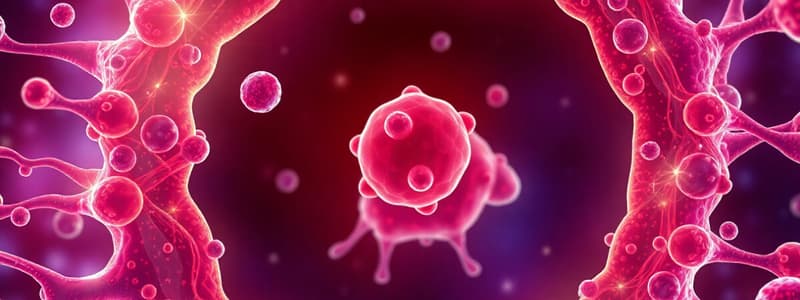Podcast
Questions and Answers
What is the process called when an unspecialized cell becomes specialized?
What is the process called when an unspecialized cell becomes specialized?
- Cell fusion
- Cell proliferation
- Cell differentiation (correct)
- Cell division
Which of the following is NOT one of the four major categories of cells?
Which of the following is NOT one of the four major categories of cells?
- Muscle cells
- Epithelial cells
- Connective-tissue cells
- Neuronal cells (correct)
What percentage of total body fluid is intracellular fluid?
What percentage of total body fluid is intracellular fluid?
- 40% (correct)
- 60%
- 20%
- 80%
Which fluid has high levels of potassium (K⁺) and magnesium (Mg²⁺)?
Which fluid has high levels of potassium (K⁺) and magnesium (Mg²⁺)?
What is the primary function of homeostasis in the body?
What is the primary function of homeostasis in the body?
Who is recognized as the Father of Physiology for his contributions to homeostasis?
Who is recognized as the Father of Physiology for his contributions to homeostasis?
Which type of muscle cell is responsible for involuntary movements and is found in organs?
Which type of muscle cell is responsible for involuntary movements and is found in organs?
In terms of composition, what is a distinguishing feature of extracellular fluid?
In terms of composition, what is a distinguishing feature of extracellular fluid?
Flashcards
Homeostasis
Homeostasis
The body's process of maintaining a stable internal environment despite external changes.
Cell Differentiation
Cell Differentiation
Transforming an unspecialized cell into a specialized cell for a specific function.
Intracellular Fluid
Intracellular Fluid
Fluid inside the body's cells.
Extracellular Fluid
Extracellular Fluid
Signup and view all the flashcards
Plasma
Plasma
Signup and view all the flashcards
Interstitial Fluid
Interstitial Fluid
Signup and view all the flashcards
High Sodium, Extracellular
High Sodium, Extracellular
Signup and view all the flashcards
High Potassium, Intracellular
High Potassium, Intracellular
Signup and view all the flashcards
Study Notes
Homeostasis
- Homeostasis is the body's process of maintaining a stable internal environment despite external changes.
- This internal balance is crucial for proper cell, organ, and system function.
- Claude Bernard is considered the "Father of Physiology."
Cellular Structure and Organization
- Cells are the basic structural units of a multicellular organism.
- Cells specialize during development, becoming specialized for specific functions.
- Cell differentiation is the transformation of unspecialized cells into specialized cells.
- Cells are classified into four major categories:
- Muscle cells
- Neurons
- Epithelial cells
- Connective tissue cells
- Multiple tissue types combine to form organs.
- Organs work together as organ systems.
- Atoms -> Molecules -> Macromolecules -> Organelles -> Cells -> Tissues -> Organs -> Organ Systems -> Organism
Body Fluid Compartments
- Total body fluid is approximately 60% of total body weight.
- Intracellular fluid (ICF) is found inside the cells, comprising approximately 40% of total body fluid.
- Extracellular fluid (ECF) is found outside cells, making up approximately 20% of total body fluid.
- Plasma/ Intravascular fluid: ~ 5% of ECF
- Interstitial fluid: ~ 15% of ECF
- Transcellular fluid: ~ <1% of ECF (e.g., cerebrospinal fluid, synovial fluid)
- A 70-kg adult man has roughly 42 liters of total body water.
Composition of Body Fluids
- Extracellular fluid (plasma) has high levels of sodium (Na+), chloride (Cl-), and bicarbonate (HCO3-).
- The osmolarity of extracellular fluid is 290 mosm/L.
- Intracellular fluid has high levels of potassium (K+), magnesium (Mg2+), and phosphates.
- The osmolarity of intracellular fluid is 290 mosm/L.
Homeostasis & Stress
- Homeostatic mechanisms maintain stable internal conditions.
- Disruptions in homeostasis can cause health issues like diabetes, high blood pressure and heatstroke.
- Stress can disturb homeostasis.
- Chronic stress can impair the immune system function and increase the risk of other diseases.
Importance of Homeostasis
-
Maintaining homeostasis keeps the internal environment stable.
-
The nervous system helps manage changes promptly.
-
The endocrine system regulates longer-term changes through hormonal control.
Key Aspects of Homeostasis
- Temperature regulation: The body maintains a core temperature of 37°C (98.6°F) through sweating and shivering.
- Fluid balance: The body manages water and ion levels through urine production regulated by hormones.
- Kidneys excrete waste and regulate water and electrolyte levels.
- Blood glucose regulation: Hormones (insulin and glucagon) regulate blood glucose levels.
- High blood sugar can lead to diabetes.
- pH balance (acid-base balance): The body keeps the blood pH near 7.4.
- Set point concept: The parameters kept stable by homeostasis (e.g., body temperature, blood sugar, blood pressure).
- Homeostasis and stress mechanisms are involved in maintaining body health
Homeostasis and Negative Feedback
- Homeostasis employs negative feedback mechanisms to counteract deviations from the set point.
- If body temperature rises, the body will initiate processes like sweating to reduce temperature.
Homeostasis and Positive Feedback
- Positive feedback mechanisms amplify a change to a particular set point.
- During childbirth, the release of the hormone oxytocin causes uterine contractions to become stronger.
Factors in Homeostasis Regulation
- Hormones: Chemical messengers that regulate functions.
- Examples include insulin (lowers blood sugar), glucagon (raises blood sugar), adrenaline (increases heart rate & energy), and aldosterone (controls water & salt balance).
- Neurotransmitters: Chemical messengers in the nervous system.
- Examples include dopamine, serotonin, and acetylcholine.
- Cytokines: Proteins involved in immune responses.
- Examples include interleukin, tumor necrosis factor (TNF).
- Electrolytes: Ions essential for water balance, nerve signaling, and muscle function.
- Sodium (Na+), potassium (K+), and calcium (Ca2+) are examples.
Studying That Suits You
Use AI to generate personalized quizzes and flashcards to suit your learning preferences.




